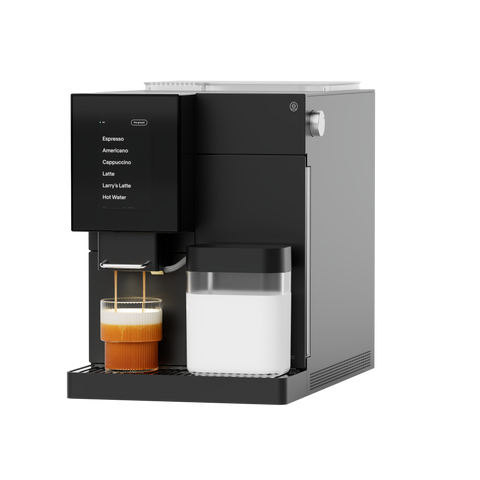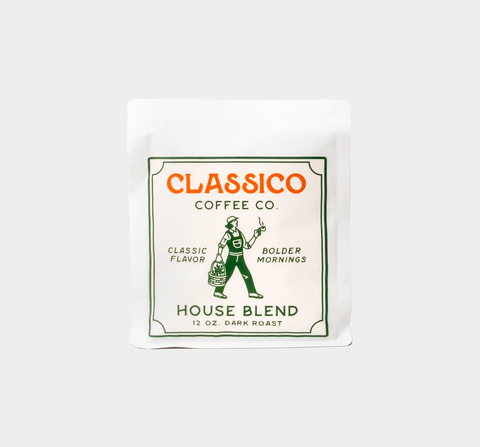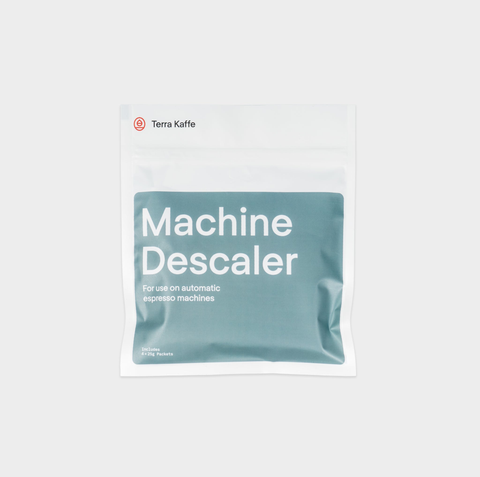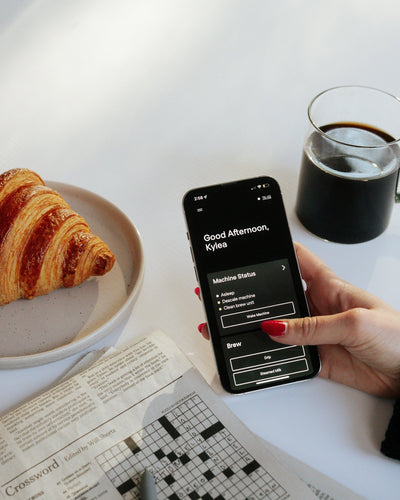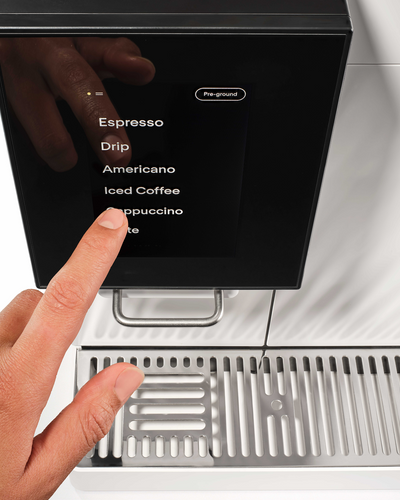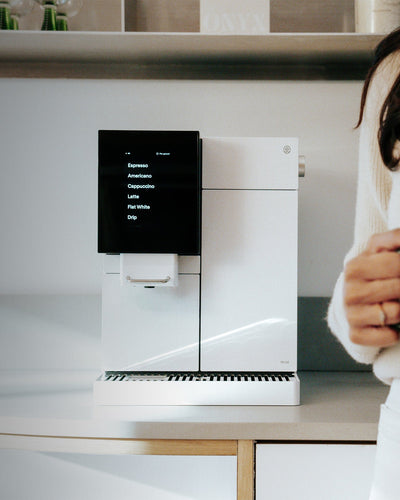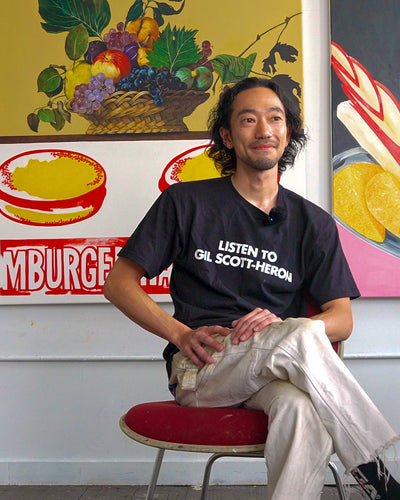I met Justin and his dog Artie in the lobby of The Newlab, a membership-based co-working space, home to 800+ entrepreneurs and hardware startups in Brooklyn’s Navy Yard. Justin founded Vela Bikes with co-founder Victor Hugo Cruz. Victor has been manufacturing electric bikes from his São Paulo warehouse since 2012. Over the course of an hour, I had the pleasure of trying out one of Vela’s e-bikes with Justin. As we zipped in and around Navy Yard traffic, we spoke about the virtues of great design, how we can better explore our cities, and how technology can enhance the ways we enjoy our daily rituals — something Terra Kaffe knows well.

Justin Kosmides: You Citibike over?
I did. And I parked right at the gate.
JK: Electric, or did you get a normal one?
I got the electric — It was the only one they had. And it worked out great.
JK: The eternal challenge of always hunting down electric Citibikes [laughs].
And I live right next to a docking station. So what I do is, I'll grab hold of my helmet in my hand at the front door to check the Citibike app. And that'll be my go, no-go right there. And usually, it doesn't work out.
JK: It's like the age-old NYC ritual of knowing exactly how long it takes to get to the subway platform. Like, "Okay. Go! Go! Go!"
Sometimes I'll have to Citibike just the two blocks to the train station to make sure I got it just right.
But yeah, thanks so much for taking the time to answer some questions! I feel like there's a lot of shared vision between the two brands, and it's always fun to talk to people. Tell me a little bit about Vela; how'd you get started? What was the vision? What was the dream?
JK: So the real roots start with me always being a lifelong cyclist. And while I'm passionate about cycling, I’m also fascinated by transportation and better ways of getting around cities. E-biking is the convergence of that passion for cycling and the fascination of getting around cities more efficiently. I was in the middle of a decade in the banking industry, and it had become that soul-sucking grind. But the one joy that I really found was when I got an e-bike here in Brooklyn to commute up to Midtown [Manhattan]. I discovered e-bikes because I lived around the corner from the first VanMoof store in the United States and was lucky enough to get one of the early Electrified S bikes that they sold. And I’m not trying to be cheesy here, but it really transformed my life. Instead of getting jammed onto the F train daily like a sardine, showing up sweaty and nasty after a subway ride. For the first time, I could have a completely new route each day. I started exploring different coffee shops along the way. I discovered how much I loved sitting and enjoying a simple espresso in the morning. And so it was this freedom, this freedom in mobility to be like, "I want to go this way. I want to go this route."That was really where the love affair with e-bikes started. I could wear my suit, I didn't have to worry about showering or changing. I could literally hop off my e-bike and go right into a banking meeting.
But then I got transferred to Los Angeles. Many people don’t realize that it's one of the best biking places in the country, in terms of weather and routes. Unfortunately, the culture of biking wasn't there, But I continued to e-bike out there, to and from the office. I really enjoyed that same kind of freedom, but in a completely different setting. And so those two experiences in two very different cities and cultures were really the foundation. Around then, very coincidentally, I was at a wedding where I was connected with Vela Bikes and the original founder, Victor Cruz, who continues to design and engineer our bicycles to this day. He’s the real mad scientist/genius who got this brand started in São Paulo, Brazil.
And were they electric originally as well?
JK: Yeah, they’ve always been electric. Victor had been following the growth in the European electric bike industry and wanted to bring electric bikes back to São Paulo, in an affordable, economical way, yet still looking beautiful. And he was smart enough to know that he could take the technology of all these incredible European brands — but add that with the styling, feeling, and beautiful design — that is really core to our brand. Which is the case with the first bike we've ever built; marrying that idea of beautiful design with leading technology.
We decided to launch the brand into the US market. This was just before the pandemic, and then as the pandemic started to get worse and worse and we knew we couldn't wait any longer, so we brought in our first bikes and sold them out instantaneously, like every other bike in the world [laughs]. But we noticed something interesting with that first batch of customers — they were over two-thirds female; the micromobility and e-bikes industry at the time was heavily male-dominated, over 75% of e-bikes at one point were sold to males. And so we think that the approachable design, not having the ripping-through-the-woods-at-20-miles-per-hour branding, we think all that really attracts a new type of rider to the space.

That's interesting that you went with that classic style of the bike; that old-school French-style frame. It's similar to Terra Kaffe, where we like to say that we're reinventing modern classics. Because espresso is one of the most classic ideas of coffee. The old-world charm of pneumatics and brewing espresso, where we apply a functional design element to it, with high-minded, best-in-class technology. Where we really retain that quality, but honestly, up it even more so with more focus on industrial design. So I'm curious if you could speak a little bit more on going that route where you merge a classic look with high tech. What was your thinking in making that classic look emblematic of your brand?
JK: Yeah, it's a core part of our design. There are two pieces to that:
I find it fascinating that when we reach the point in technological advancements — from cellphones to e-bikes to coffee machines — where crucial functionality is not limiting the design decisions. The technology and the design have equal roles in determining what the end product is realized as.
And so, for us, the bike battery is now small and capable enough to be incorporated into the frame as part of the seat post. The SIM card, the electronics, the motherboard, and all this incredible computing power (similar to that of the Apollo missions [laughs]) can literally be small enough that it fits inside this beautiful leather pouch at the front of the bike. And we're lucky enough to be at the right time, the right place, and have enough advancements that we can let the designer take a greater lead.
The second part is that I fell in love with bikes through classic bike designs. And though there are a lot of these brands out there, like the Vanmoofs and the Rad Power Bikes, that are creating beautiful designs, they are, in many ways, very cold and lifeless. And so a lot of times we talk about like the future, and the idea of the future is very warm and aesthetically inviting. You commented on the design — it's a 1970s French-style bike design that the bike was designed around. Owning homage to that classic, beautiful design like how an old [Porsche] 911 has those classic lines and shapes. In a lot of the conversations that Victor and I have, we look at brands like Tesla, which are cold and too minimalistic. We focus on that warm, inviting feeling a product can have, how those little details feel to touch, that nostalgic feeling you might have. We both believe that we don't need to sacrifice that in the future with a tradeoff for technological advancement. We can have both. It's about retaining the basics of it all. Whether it's high-quality coffee, high-quality leather, or high-quality touch and feel.


As we were walking through The Newlab, you were showing me some of your neighbors who are also building e-bikes and e-motorcycles. We work in a category where it's as friendly as it can be, but we look at our competition — whether it's other super-automatic machines or pod-based machines — with a certain amount of contention with some of the ways they do things, just as a standard of business (we think we can do it better). But the way you're kind of talking about VanMoof, for instance, it really does seem friendly, almost collaborative, and you guys kind of share insights. Could you tell me more about that?
JK: Yeah. I believe that in a market with this much growth and opportunity, a rising tide will lift all ships. Every e-bike company has the same core mission focused on taking more cars off the road, reducing CO2, and in doing so, making this planet better, making our cities more friendly. Quite frankly, I know there's the right customer for VanMoof, and I know there's the right customer for us. And I know there's a right customer for a Rad Wagon. And it's like, there's all of that is sharing in an incredible growth in unison. Everyone's doing something a little bit different. So the person who gravitates to Vela is someone who says, "I don't necessarily need to have the top speed. I don't to have the most insane this or the most insane that. Vela has something that, quite frankly, is more than good enough for all my needs. It has all the technology. And for me, it's something that is more an expression of my personality and character, and I want to show up in this type of sneaker and this style of clothing, and I want my bike to be an extension of that." We often talk about car culture and the type of car you drive reflecting your personality, I’d like us all to start talking about our bike culture more!
I think each brand does a really good job of building its own community, and they need to remember the importance of that community as they scale. That's something that is fundamental to us. With what we're building, our goal is always to stay true to our community, and not sacrifice that to sell a few more bikes.
You also mentioned earlier the bike culture of LA versus the bike culture in NYC. I mean, I think anybody with eyes who steps foot on the street can see that there is a growing demand for bikes and bike lanes. What do you think is tantamount to any good bike culture, beyond just the infrastructure, and how does that influence what you're doing at Vela?
JK: There's this moment with bikers that happens when you come to a stoplight. Doesn't matter if you're in Amsterdam, Berlin, Boston, New York, or even LA, you come to a stoplight, and you have this kind of little pack. You've got the delivery guy, you got a guy in the suit, you've got the mom with a cargo bike, you've got the person with the Citibike; you've got all these different people. And there's a sense of togetherness. That camaraderie and this mini-community that the riders all experience at the same time. That's kind of like, "we're in this together." But underlying that, it takes investment in infrastructure from cities. Something unique happened halfway through the pandemic, where the number of women riding city bikes equaled (and then surpassed) men. And that was only because cars and traffic were reduced around the city, so people finally, for the first time, felt comfortable enough to get out there and experience the freedom in mobility.
American cities (but also global cities, too — look at Paris, for instance) are finally realizing the benefits of becoming more bike-friendly and offering serious alternative modes of transportation. This is an investment that really takes more than just simply painting a bike lane, though — cities have to dedicate shared, protected bike lanes, and expand who can access e-bikes through greater incentives and subsidied programs. What Denver's doing with tax incentives for the residents, for instance. You see a growing number of cities that have committed to better, safer infrastructure from one side and wider, more equiable access to these vehicles from the other side of the equation. Those cities have seen the pandemic-induced boom continue as life returns to “normal.”
Right, the pandemic was a sort of a temperature check. It's interesting you mentioned Denver, because I lived there for about four and a half years right out of college. And it was my first time owning a bike for transportation. I was born and raised in NYC, and before I left for Denver, Citibike had only been around three or four years. So it wasn't as big as it is now. But I used it once or twice to go across town. And I saw the value there. But it was at its infancy stage, where docking stations only existed for a 40-block radius in Manhattan, 20 blocks up and down, and a few avenues east and west. And so I biked all the way to a friend's place all the way on the other side of town. And it was great. And then I realized, "oh, I'm stuck." Because the closest dock after getting to his apartment was 20 blocks back. So that was a big pain [laughs].
But in Denver, the culture there was so interesting. You talked about this camaraderie and sort of the social club aspect of biking, and that was super prevalent in Denver. Every 10 blocks, you're going to find a café, slash beer hall, slash bar, slash bike repair shop where the whole spot is dedicated to biking, repairing, hanging out — it's really something else.
JK: [Laughs] Yeah! I'm a road biker, too, and I feel like a lot of sports, and a lot of things have like have their own version of the "cool kids club." Biking is such an incredible group experience. And when you're road biking, you literally take turns on who gets hit with the most amount of wind and deflects that wind for everyone else in the group. But it's a shared experience that everyone kind of rotates through, and everyone powers through. And when you look at the pandemic and see people wanting to get out and explore, biking was such an answer to explore and try new things. Everyone and their mother wanted a bike. Because it allowed people to get out and be together but also be outside and feel freedom, so it checked a lot of boxes we were all looking for at the time.
Vela has hosted so many of these community rides, and it was such an incredible experience to hear people say, "Oh, I haven't had the chance to go out and bike in the city, and this makes me feel safe." The great thing about e-bikes is that it lowers the barriers of entry for people to participate. It's weight agnostic, it's size agnostic; it’s sweat proof — which is a real barrier. It allows people like my girlfriend to put on their makeup and zip to work and pass people who are dripping in sweat. [Laughs] That's the kind of type of democratization of freedom that e-bikes allow for, whereas biking used to be only for the strongest people or those who didn't have to carry stuff with them, for example. You want to be able to stop and pick up groceries and still have that freedom.

I didn't have a car the entire time I lived in Denver. The whole time, I lived right next to the light rail, which would take me to my office seven miles away. There'd be another mile or so, but I took the bike with me with a train and then biked the rest of the way. So at a certain point, I said to myself, "You know what, I don't need a car. But it would be nice to have a Vespa." And so I saved up a bunch of money over the course of a year. And then there were two barriers of entry, the first of which was the "cargo" version of the Vespa, if you can even call it that. Before, I wouldn't be able to get to Trader Joe's without having to stuff my backpack, put it on my back, and just literally break my back on a bike. But even then, the cargo version of the Vespa only held up to 15 pounds on the rack, which proved to be useless. But the other barrier was having to find or pay for a parking space. With an e-bike, my apartment is my parking space. But I digress.
Having worked with Terra Kaffe for a while, I know that with everything you make and everything you ID, there's always a story of trade-offs. You start with a grand vision of the perfect blueprint or schematic, and you whittle it down from there. Speaking about finding these solutions to transportation problems, what are some of the things that you wanted to see in your bikes that you didn't get to see or had to trade off?
JK: Yeah, I think it's always about trade-offs. I mean, we've made a choice to make a bike that hides technology, so one thing that we've had to contend with is we've got what is considered a kind of middle-of-the-road battery pack for US standards. And while it goes 20-40miles on a charge, people always want more. And I think when 95% of your rides can be accomplished in X mileage, why do you need to have a giant battery weighing you down? And a lot of people are asking this question, and I think it's a good question to ask not only with your bike but other parts of your daily usage. Do you need an electric car that goes 400 miles when 95% of your trips are under 10 miles? Do you need an electric bike that has a 500-watt-hour battery, when 90% of your rides can be accomplished by a smaller battery pack? But the basic question is, do you need all of that functionality? Do you need all of this capacity? Is it just peace of mind that you're getting out of having this massive, massive battery pack? And so we've made a conscious choice not to expand our battery pack because, quite frankly, it solves most, if not all your needs.
And we've built out a fast charging network of 25, almost 30 locations in São Paulo, Brazil. And that fast charging dock allows you, in a 10 to 15-minute charge, to get enough — I like to quote it in terms of New York distances — enough of a range to get from Williamsburg to SoHo and back. So let's say you forget to charge your battery the night before, and you're near empty. So you can stop off at your local café or yoga studio and charge for 10 minutes while you enjoy coffee. We're getting ready to roll out our charging network here in New York, we've got our first 10 locations that are going live in Spring, and that charging network is an incredible system that, again, removes the need for you to carry around the largest possible battery. And so we made a sacrifice to shrink that. But instead, we've built out this incredible network that allows you to tap into an incredible community. For instance, one of our spots, Hudson Wilder, is going to be actually our first official charging station.
So picture this: You're zipping around Brooklyn coming from Upper East Side. You've spent all day biking to restaurants and hanging out with your friends. Then you're like, "I'm not going to make it all the way back to the Upper East Side," after covering all of this incredible distance and range. So you pull up your Vela app. And on your Vela app, you see this charging dock. And you're like, "What is this? Hudson Wilder?" So you can click for more information, it goes to their Instagram profile, and you stop by for a little recharge, have a coffee, and explore something you would have never discovered without that app. So where there was a sacrifice, we found a benefit.


It's the same with cars. Americans love having gigantic cars [laughs].
JK: Right? They're huge! I was just having this conversation in Detroit. We just launched our new production line in Detroit, so we're now US made. And a lot of the auto companies are actually starting to invest more in electric bikes, because electric bikes have outpaced electric cars for the past two years as the top-selling electric vehicle, and will continue to do so for the next 10 years. Electric bikes will be the fastest-growing electric vehicle. But we were comparing battery packs to the electric Ford F-150. And we determined that close to about 400 of our battery packs are in one Ford F-150.
But the thing that that's kind of sort of shining through with a lot of what you're saying is similar to us. Whether it's an electric bike or electric coffee machine, convenience is part and parcel of the business. I mean, we are offering many things, but one of those things is the convenience of push-button brewing or push-button pedal assist. But it's not the be-all-end-all, right? For us, it's really about unlocking or elevating the coffee ritual. Save time here, so that you can enjoy the end goal, which is the coffee ritual, ultimately. So how do you sort of think of that, similarly, as a ritual of the bike ride versus just, getting to skip the subway?
JK: The convenience of an e-bike is undeniable, it gives you a new ability to enjoy the world around you, the fresh air flowing, the extra time to stop at that cool-looking shop you've always wanted to go inside but never had the chance, the ability not to show up dripping in sweat. Micromobility provides the convenience of shrinking the size of the city the way more traditional forms of transportation can’t and reduces the things that are often restrictions/limitations — from parking, to operating cost, to traffic, to fixed and often unreliable transportation schedules.
The ritual part for us is to elevate that experience beyond what you’re already experiencing. I actually praise, and I’m a huge fan of CitiBike, they are our gateway drug. People try the electric CitiBikes or other public e-bike shares, and then seem to find us when they want to elevate their ride. We have focused on making a product that doesn't just look good but also functions at a higher level than the market. I like to obsess over something as small as our handlebar grips [laughs]. They come from one supplier. Of course, everyone got hit with supply chain issues during the peak of the pandemic, but the feeling of those handlebar grips is part of what makes a Vela a Vela. . So we literally had to halt production for a painful number of months until we caught up with those grips. But I think it's important to stay true to that with the product you've been making. It's also the reason we decided to onshore our production to Detroit, one of the only facilities in the country. It gives us more freedom to elevate the product.
Can I ask you — I'm curious about the app with the TK-02. Did you make the machine first, or did you already have an app?
The app was built in tandem with the machine. A lot of other brands will make an app as an afterthought. They'll make the machine knowing they want it to be "connected" in some way, then they'll make an app around it. We started designing and building TK-02 at the exact same time that we built the app. It was never meant to be an add-on for TK-02. Rather, it's a completely connected experience from tip to tail. It allows people to be more connected to their coffee from the jump. So while it can do the fun, simple things like brewing from your phone and having coffee in bed, the real customizable features and impressive coffee features are unlocked by the app. Because as beautiful as the screen on TK-02 is, nobody wants to bend over in front of their machine and tinker around with settings for minutes on end. So TK-02 puts all that control in the palm of your hands, with a more natural presentation.
JK: Similar to us, too! Our first version of the product, the Vela 1, is not connected. The second version, we moved to make it connected. And that shared app experience really helps the entire experience from start to finish. You don't necessarily need it to get a great ride, but it enhances an already great experience.
Amen.
You can learn more about Vela’s products and mission at their website, www.velabikes.com, and follow them on Instagram @velabikes.

